| Home | Current show | Photography/Calligraphy | Show archives | Japanese pottery | Tea bowls | Sumi-e | Gallery tour | Wabi sabi |

Touching Stone Gallery Santa Fe New Mexico USA
www.touchingstone.com Email: director@touchingstone.com

Touching Stone Gallery Santa Fe New Mexico USA
www.touchingstone.com Email: director@touchingstone.com
| Tadashi Nishihata Living Tradition in Japanese Pottery June 30 - August 2, 2006 See more of this artist's work in: Nishihata's 2003 show 2004 show 2006 show 2008 show 2010 show 2013 show |
|
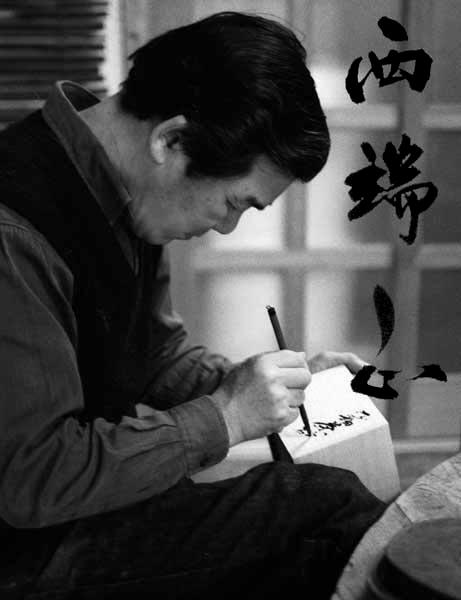 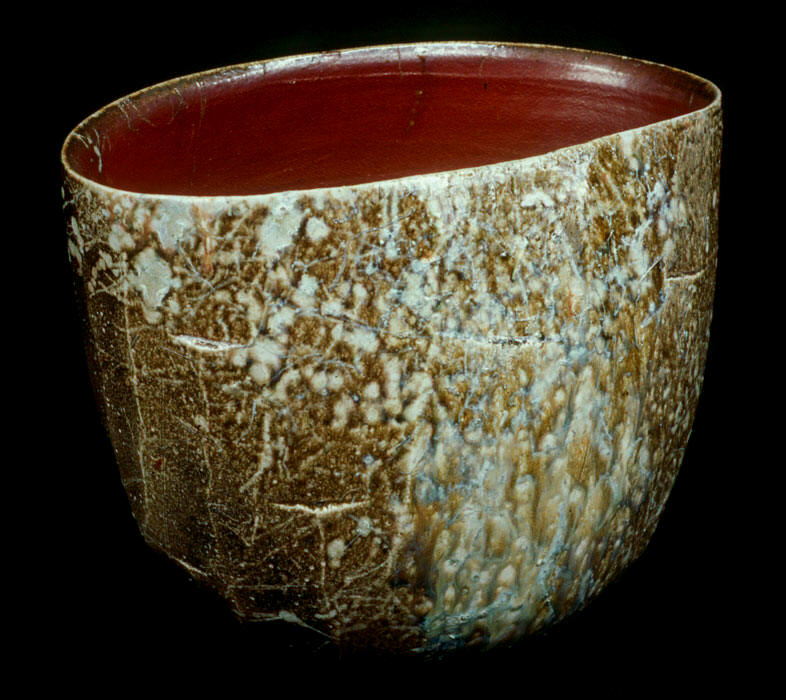 |
|
| Tadashi
Nishihata 西端正 Nestled in a beautiful valley along the Shitodani River that runs through towering mountains northwest of Kyoto is the picturesque village Tachikui, historically known as Tanba* 丹波, one of the six oldest pottery centers in Japan. The rich ferrous soil in this area has supported generations of farmers and artisans since the Kamakura period (1180 - 1230). Tanba pottery is fired traditionally with wood. The oldest working noborigama (climbing kilns) in Japan are still used here. This serene setting is home of some of the world’s most beautiful ceramics. Tadashi Nishihata (b. 1948) comes from a family steeped in Tanba pottery traditions. His great great great grandfather Ichifusa was a master potter known for his figurative sake bottles in the late Edo period (early 19th century). Nishihata’s father, Sueharu (b. 1926), is a respected ceramist who has exhibited extensively. The long historic and familial background provides tremendous depth for Nishihata’s life-long pursuit in Tanba pottery. Among Nishihata’s many achievements, his most significant contribution to Tanba pottery is the re-establishment of an ancient Tanba finish, called Akadobe-yu (red clay glaze). In the early Edo period (1603 – 1867), some Tanba potters applied a certain type of glaze onto their pots to make them water-tight. Their glazed pottery turned a distinctive deep reddish color after firing. Inexplicably, pottery with this beautiful color was made for only 20 to 30 years, after which the method for creating it was lost. For almost four centuries, numerous potters have tried to reproduce this ancient finish without success. Tadashi Nishihata experimented for more than 30 years using different clay and firing techniques in an attempt to re-create the Akadobe-yu finish. In 2001, he successfully reproduced the deep chestnut-red Akadobe-yu finish. Nishihata gained wide recognition not only for this accomplishment, but also for his generosity in sharing his hard-earned knowledge with his peers. Nishihata's other accomplishments include his unique Hai-yu finish, a turquoise-colored glaze made from ashes of the rice plant and different types of wood. Much of his work is inspired by nature. Every winter, wind from the Sea of Japan brings snow to the mountains around Tanba, transforming the valley into a wonderland of frosted rocks and forests. In the spring, melting snow turns rivers and streams emerald, new leaves decorate the drab earth with brilliant green. Nishihata captures the changing seasons using wood fire with as much drama and nuance as a painter using colors. The distinctive surface texture on many of his works is attributed to a unique clay that he discovered some years ago while hiking in a remote mountain near his home. In 1994, Nishihata won the Grand Prize of the Chanoyu Zokei Ten (Modern Tea Forms) Exhibition sponsored by the Tanabe Museum of Art. In 2003, Nishihata was selected along with three other Japanese tea bowl masters to show in America at Touching Stone Gallery. A year later, Nishihata followed with a successful solo exhibition in the same gallery. In 2005, Nishihata won the coveted Grand Prize of the Chanoyu Zokei Ten Exhibition for a second time. And in 2006, he repeated this feat by winning the same Prize for the third time, thus becoming the only artist who has ever been bestowed with this prestigious award in two consecutive years. This exhibition at Touching Stone Gallery is a tribute to this exceptional artist. The exhibition includes outstanding examples of Nishihata’s Akadobe-yu, Hai-yu, as well as his traditional unglazed fire-changed ceramics. In addition to this exhibition, Nishihata's work has been selected for the 2006 Santa Fe International Folk Art Market sponsored by the Museum of International Folk Art of New Mexico. * Tan 丹(red)-波(wave) got its name from a kind of red rice grown in ancient time which turned the area into a sea of red. The name is often written as Tamba. Tanba is used here to preserve the original meaning and pronunciation, following revised Hepburn romanization. Click on images to view selected pieces Inquiry/order: director@touchingstone.com, see Inquiry/Order |
|
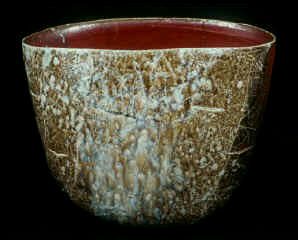 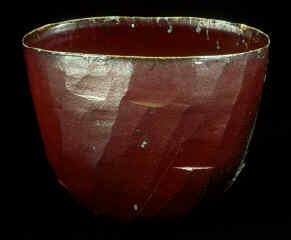 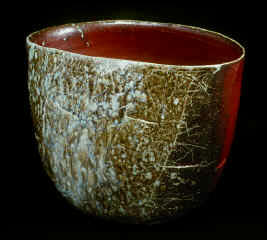 |
|
| Mentori Bowl
No. 1 w/ Akadobe-yu finish wood-fired ceramic 12"h x 16"w x 11"d (3 views) Sold |
|
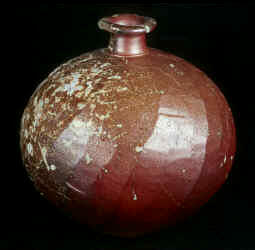 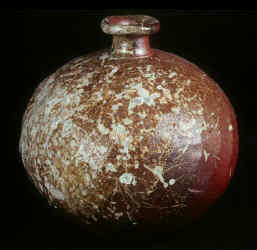 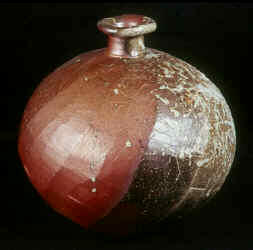 |
|
| Mentori Vase
No. 2 w/ Akadobe-yu finish wood-fired ceramic 14"h x 13.5"w x 13.5"d (3 views) Sold |
|
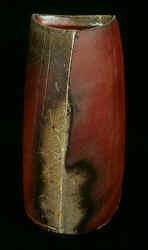 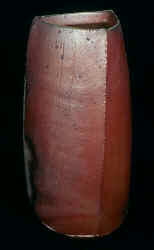 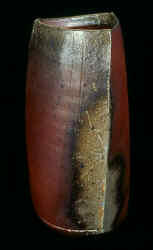 |
|
| Vase No. 3 w/
Akadobe-yu finish wood-fired ceramic 15"h x 7"w x 7.5"d (3 views) Sold |
|
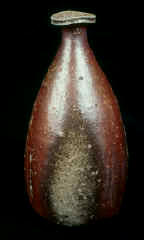 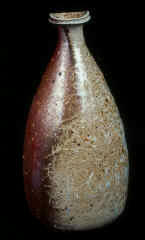 |
|
| Fire-changed Vase No. 4
wood-fired ceramic 13.5"h x 7.5"w x 7.5"d (2 views) Sold |
Vase No. 5 w/ Akadobe-yu
finish wood-fired ceramic 13.5"h x 7"w x 7"d (2 views) Sold |
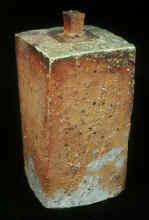 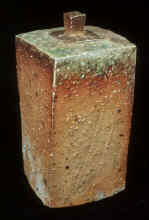 |
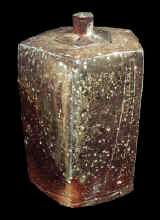 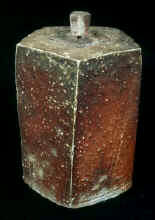 |
| Fire-changed Incense Burner
No. 6 wood-fired ceramic 8"h x 3.5"w x 3.5"d (2 views) Sold |
Fire-changed Incense Burner
No. 7 wood-fired ceramic 8"h x 5"w x 5"d (2 views) Sold |
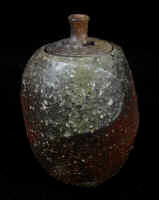 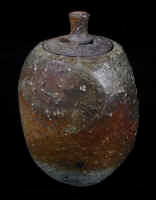 |
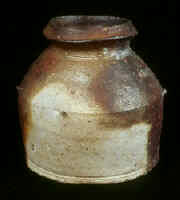 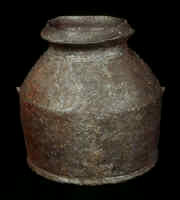 |
| Fire-changed Incense Burner
No. 8 wood-fired ceramic 6"h x 4"w x 4"d (2 views) Sold |
Fire-changed Jar No. 9
wood-fired ceramic 6"h x 6" x 5" (2 views) Sold |
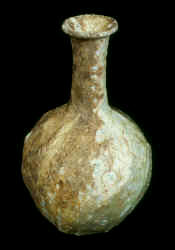 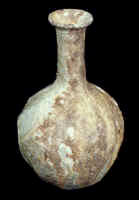 |
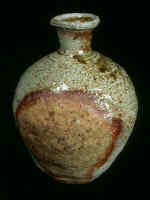 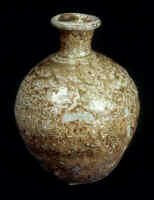 |
| Tokkuri No. 10 w/ Natural
ash glaze wood-fired ceramic 6.5"h x 4"w x 4"d (2 views) Sold |
Tokkuri No. 11 w/ Natural
ash glaze wood-fired ceramic 5.5"h x 4.5"w x 4.5"d (2 views) Sold |
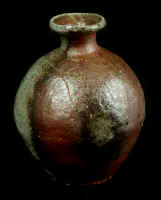 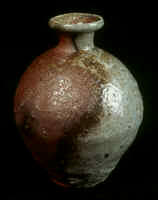 |
  |
|
Tokkuri No. 12 w/ Akadobe-yu finish wood-fired ceramic 5.5"h x 4.5"w x 4.5"d (2 views) Sold |
Fire-changed Hanging vase No. 13 wood-fired ceramic 10.5"h x 1.5"w x 1.5"d (2 views) Sold |
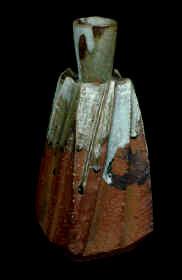 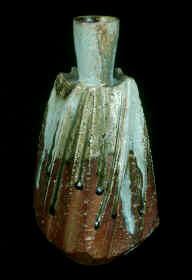 |
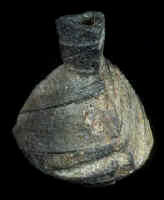 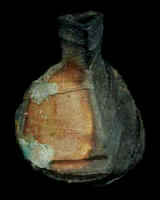 |
| Vase No. 31 w/ Hai-yu
finish wood-fired ceramic 11"h x 5"w x 5"d (2 views) Sold |
Fire-changed Vase No. 33 wood-fired ceramic 7.5"h x 6"w x 6"d (2 views) Sold |
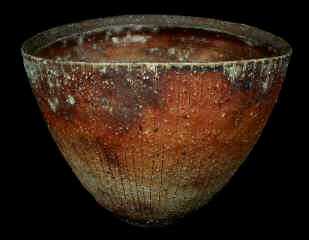 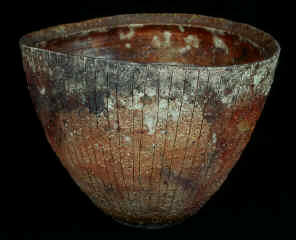 |
|
| Fire-changed
Vase No. 32 w/ Fine lines wood-fired ceramic 9"h x 13"w x 10"d (2 views) Sold |
|
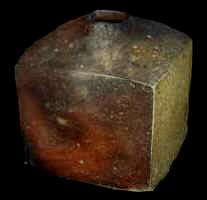 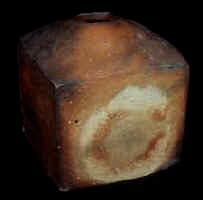 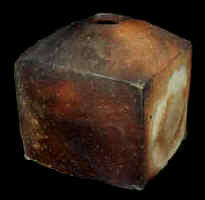 |
|
| Fire-changed
Four-faced Vase No. 34 wood-fired ceramic 8.5"h x 8"w x 8"d (3 views) Sold |
|
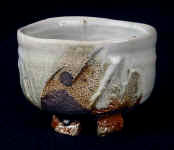 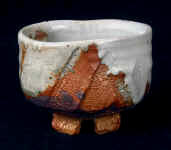 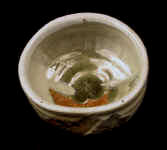 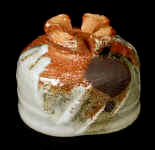
|
|
| Tea Bowl No.
16A w/ Hai-yu finish (w/ wooden box) wood-fired ceramic 4"h x 5"w x 4.5"d (4 views) Sold |
|
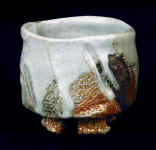 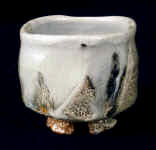 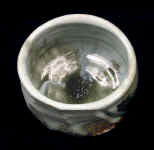 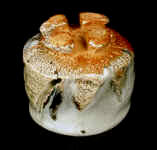 |
|
| Tea Bowl No. 17
w/ Hai-yu finish (w/ wooden box) wood-fired ceramic 4"h x 4"w x 3.5"d (4 views) Sold |
|
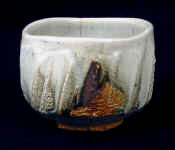 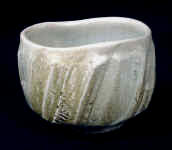 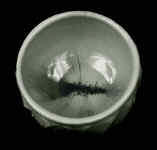 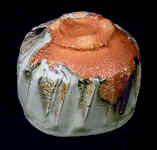 |
|
| Tea Bowl No. 18
w/ Hai-yu finish (w/ wooden box) wood-fired ceramic 4"h x 4.75"w x 4.5"d (4 views) Sold |
|
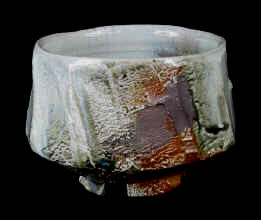 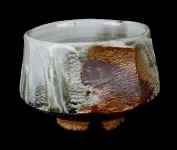 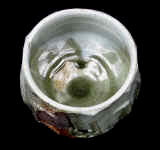 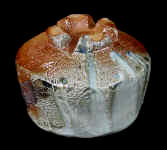 |
|
| Tea Bowl No. 19
w/ Hai-yu finish (w/ wooden box) wood-fired ceramic 4"h x 5.5"w x 5.5"d (4 views) Sold |
|
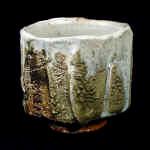 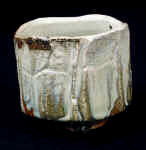 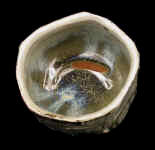 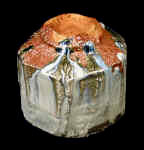 |
|
|
Tea Bowl No. 20 w/ Hai-yu finish (w/
wooden box) wood-fired ceramic 4"h x 4"w x 3.5"d (4 views) Sold |
|
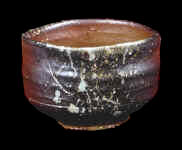 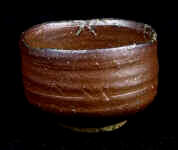 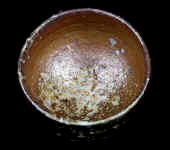 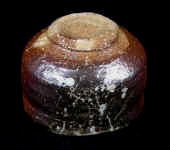 |
|
| Tea Bowl No. 22
w/ Akadobe-yu finish (w/ wooden box) wood-fired ceramic 3.5"h x 5"w x 4.5"d (4 views) Sold |
|
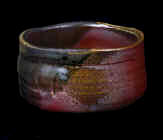 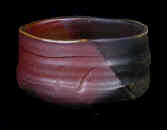 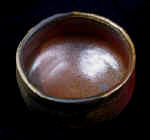 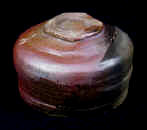 |
|
| Tea Bowl No. 23
w/ Akadobe-yu finish (w/ wooden box) wood-fired ceramic 3.25"h x 4.75"w x 4.5"d (4 views) Sold |
|
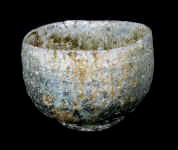 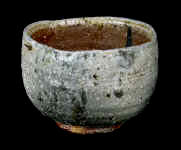 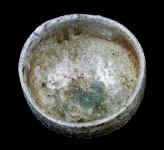 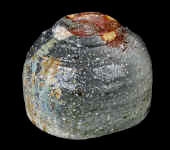 |
|
| Fire-changed
Tea Bowl No. 24 (w/ wooden box) wood-fired ceramic 3.5"h x 5"w x 5"d (4 views) Sold |
|
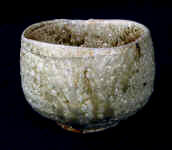 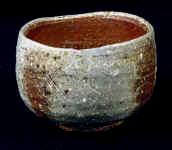 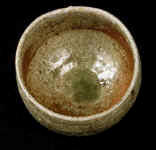 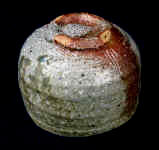 |
|
| Fire-changed
Tea Bowl No. 25 (w/ wooden box) wood-fired ceramic 3.5"h x 4.5"w x 4.5"d (4 views) Sold |
|
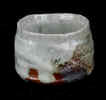 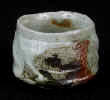 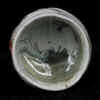 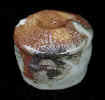 |
  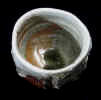  |
| Guinomi No. 27 w/ Hai-yu
finish (w/ wooden box) wood-fired ceramic 2"h x 2.5"w x 2.5"d (4 views) Sold |
Guinomi No. 28 w/ Hai-yu
finish (w/ wooden box) wood-fired ceramic 3"h x 2.5"w x 2"d (4 views) Sold |
    |
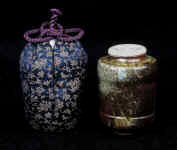 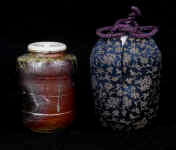 |
| Fire-changed Guinomi No. 29
(w/ wooden box) wood-fired ceramic 2.5"h x 2.5"w x 2.25"d (4 views) Sold |
Tea Caddy No. 30 w/
Akadobe-yu finish (w/ silk pouch & wooden box) wood-fired ceramic 3.5"h x 2.5"w x 2.5"d (2 views) Sold |
|
Exhibitions & Awards 1948 Born in Tachikui, Japan 1969 Began career in ceramic 1976 Honorable Mention, Hyogo Prefecture Exhibition 1978 Selected for Japan Crafts Association, Kinki Exhibition 1986 Selected for Japan Traditional Arts & Crafts Exhibition 1988 Selected for Japan Traditional Arts & Crafts Exhibition Matsushita Prize, Japan Craft Association, Kinki Exhibition 1989 President Prize, Japan Traditional Arts & Crafts Exhibition Oikawa Memorial Prize, Handon Association 1990 Selected for Japan Traditional Arts & Crafts Exhibition Honorable Mention, Chanoyu no Zokei Ten sponsored by Tanabe Museum of Art 1991 Selected for Japan Traditional Arts & Crafts Exhibition Grand Prize, Chanoyu no Zokei Ten sponsored by Tanabe Museum of Art 1992 Selected for Japan Traditional Arts & Crafts Exhibition Honorable Mention, Hyogo Prefecture Emerging Artists Japanese Ceramics Now Invitational Exhibition, Paris, France 1993 Excellence Award, Chanoyu no Zokei Ten Selected for Japan Traditional Arts & Crafts Exhibition 1994 Selected for Japan Traditional Arts & Crafts Exhibition Solo Exhibition, Mitsukoshi Department Store Gallery, Tokyo 1995 Selected for Japan Traditional Arts & Crafts Exhibition 1996 Selected for Japan Traditional Arts & Crafts Exhibition Solo Exhibition, Mitsukoshi Department Store Gallery, Tokyo Excellence Award, Chanoyu no Zokei Ten 1998 Solo Exhibition, Mitsukoshi Department Store Gallery, Tokyo 1999 Honorable Mention, Chanoyu no Zokei Ten 2000 Selected for Japan Traditional Arts & Crafts Exhibition Solo Exhibition, Mitsukoshi Department Store Gallery, Tokyo 2001 Selected for Japan Traditional Arts & Crafts Exhibition 2002 Solo Exhibitions, Mitsukoshi Department Store Gallery, Tokyo 2003 Japanese Teabowl Masterworks Exhibition, Touching Stone Gallery, Santa Fe, New Mexico 2004 Solo Exhibition, Touching Stone Gallery, Santa Fe, New Mexico 2005 Grand Prize, Chanoyu no Zokei Ten sponsored by Tanabe Museum of Art Solo Exhibition, Mitsukoshi Department Store Gallery, Tokyo 2006 Grand Prize, Chanoyu no Zokei Ten sponsored by Tanabe Museum of Art Solo Exhibition, Touching Stone Gallery, Santa Fe, New Mexico Selected artist, International Folk Art Market sponsored by Museum of International Folk Art, New Mexico
|
|